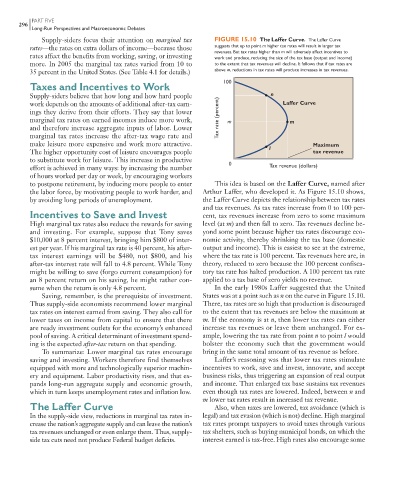Page 344 - Economics
P. 344
CONFIRMING PAGES
PART FIVE
296
Long-Run Perspectives and Macroeconomic Debates
Supply-siders focus their attention on marginal tax FIGURE 15.10 The Laffer Curve. The Laffer Curve
rates —the rates on extra dollars of income—because those suggests that up to point m higher tax rates will result in larger tax
revenues. But tax rates higher than m will adversely affect incentives to
rates affect the benefits from working, saving, or investing work and produce, reducing the size of the tax base (output and income)
more. In 2005 the marginal tax rates varied from 10 to to the extent that tax revenues will decline. It follows that if tax rates are
35 percent in the United States. (See Table 4.1 for details.) above m, reductions in tax rates will produce increases in tax revenues.
100
Taxes and Incentives to Work
Supply-siders believe that how long and how hard people n
work depends on the amounts of additional after-tax earn- Laffer Curve
ings they derive from their efforts. They say that lower
marginal tax rates on earned incomes induce more work, Tax rate (percent) m m
and therefore increase aggregate inputs of labor. Lower
marginal tax rates increase the after-tax wage rate and
make leisure more expensive and work more attractive. Maximum
The higher opportunity cost of leisure encourages people l tax revenue
to substitute work for leisure. This increase in productive 0
effort is achieved in many ways: by increasing the number Tax revenue (dollars)
of hours worked per day or week, by encouraging workers
to postpone retirement, by inducing more people to enter This idea is based on the Laffer Curve , named after
the labor force, by motivating people to work harder, and Arthur Laffer, who developed it. As Figure 15.10 shows,
by avoiding long periods of unemployment. the Laffer Curve depicts the relationship between tax rates
and tax revenues. As tax rates increase from 0 to 100 per-
Incentives to Save and Invest cent, tax revenues increase from zero to some maximum
High marginal tax rates also reduce the rewards for saving level (at m ) and then fall to zero. Tax revenues decline be-
and investing. For example, suppose that Tony saves yond some point because higher tax rates discourage eco-
$10,000 at 8 percent interest, bringing him $800 of inter- nomic activity, thereby shrinking the tax base (domestic
est per year. If his marginal tax rate is 40 percent, his after- output and income). This is easiest to see at the extreme,
tax interest earnings will be $480, not $800, and his where the tax rate is 100 percent. Tax revenues here are, in
after-tax interest rate will fall to 4.8 percent. While Tony theory, reduced to zero because the 100 percent confisca-
might be willing to save (forgo current consumption) for tory tax rate has halted production. A 100 percent tax rate
an 8 percent return on his saving, he might rather con- applied to a tax base of zero yields no revenue.
sume when the return is only 4.8 percent. In the early 1980s Laffer suggested that the United
Saving, remember, is the prerequisite of investment. States was at a point such as n on the curve in Figure 15.10 .
Thus supply-side economists recommend lower marginal There, tax rates are so high that production is discouraged
tax rates on interest earned from saving. They also call for to the extent that tax revenues are below the maximum at
lower taxes on income from capital to ensure that there m. If the economy is at n , then lower tax rates can either
are ready investment outlets for the economy’s enhanced increase tax revenues or leave them unchanged. For ex-
pool of saving. A critical determinant of investment spend- ample, lowering the tax rate from point n to point l would
ing is the expected after-tax return on that spending. bolster the economy such that the government would
To summarize: Lower marginal tax rates encourage bring in the same total amount of tax revenue as before.
saving and investing. Workers therefore find themselves Laffer’s reasoning was that lower tax rates stimulate
equipped with more and technologically superior machin- incentives to work, save and invest, innovate, and accept
ery and equipment. Labor productivity rises, and that ex- business risks, thus triggering an expansion of real output
pands long-run aggregate supply and economic growth, and income. That enlarged tax base sustains tax revenues
which in turn keeps unemployment rates and inflation low. even though tax rates are lowered. Indeed, between n and
m lower tax rates result in increased tax revenue.
The Laffer Curve Also, when taxes are lowered, tax avoidance (which is
In the supply-side view, reductions in marginal tax rates in- legal) and tax evasion (which is not) decline. High marginal
crease the nation’s aggregate supply and can leave the nation’s tax rates prompt taxpayers to avoid taxes through various
tax revenues unchanged or even enlarge them. Thus, supply- tax shelters, such as buying municipal bonds, on which the
side tax cuts need not produce Federal budget deficits. interest earned is tax-free. High rates also encourage some
9/1/06 3:17:11 PM
mcc26632_ch15_284-301.indd 296 9/1/06 3:17:11 PM
mcc26632_ch15_284-301.indd 296

